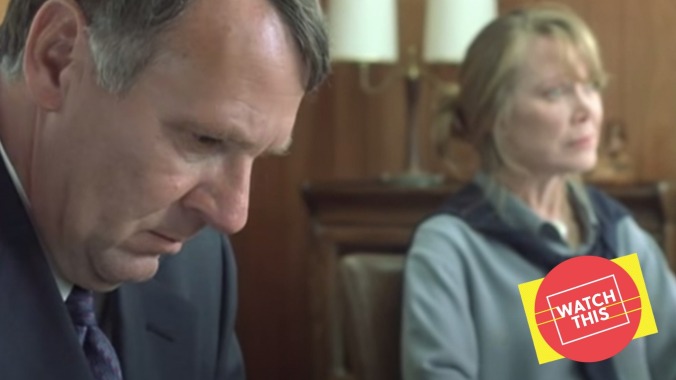The Oscar-nominated In The Bedroom fleshed out a troubling short story

Watch This offers movie recommendations inspired by new releases, premieres, current events, or occasionally just our own inscrutable whims. This week: Antlers, a horror movie adapted from a story by Nick Antosca, is not hitting theaters. In its absence, we’re looking back on other movies based on short stories.
In The Bedroom (2001)
There are, notoriously, two published versions of Raymond Carver’s short story “The Bath”: the one Gordon Lish edited—or rewrote, depending on who you ask—and Carver’s original. “A Small, Good Thing” restored the significant text Lish cut and was published in Ploughshares in 1983, two years after it appeared in the collection What We Talk About When We Talk About Love. Both stories follow a couple whose young son is hit by a car and goes into a coma. In theory, Lish’s version is more successful. It’s stark and unsentimental, and abides by the tacit rule that guides the writing of contemporary short stories: Include only as much as is needed, nothing more. And yet, one could make a case for Carver’s less efficient iteration, not because of the additional information it conveys, but because by merely spending more time with the central couple, the reader more strongly feels their fear.
There’s a similar accumulation at work in Todd Field’s In The Bedroom, adapted from a story by Carver contemporary Andre Dubus, another heavyweight of mid- to late-century short fiction. Dubus’ story also concerns a grieving couple, here an older husband and wife whose college-age son is killed by his girlfriend’s soon-to-be ex-husband. The film adaptation is long, and somewhat slow. It’s hard to tell at first what kind of movie it is. The first thing we see is Frank (Nick Stahl) and his girlfriend, Natalie (Marisa Tomei), laughing and running through a sunny field. It’s not until nearly 40 minutes in that Frank is killed—a development Dubus reveals in his very first sentence. Working in a medium that relies on compression, Dubus gets right to it, putting the focus on Matt and what he might do in response to his son’s murder. In the story, Frank is an impetus; in the film, he is first a living, breathing person.
By shifting the perspective to each main character and unfolding the film chronologically, Field is able to first establish Frank’s relationships with others, then show their devastated lives without him. It’s clear Frank cares not only for Natalie but also her two young sons. In The Bedroom is set in a small Maine town, and there’s a cookout, a lobstering trip, Red Sox on the radio. While Frank’s mother, Ruth (Sissy Spacek), is dubious of her son’s relationship with the older woman, the viewer understands their connection goes far deeper than just a “summer thing,” as Frank reassures her, because we’ve seen the two of them together. They’re in love.

 Keep scrolling for more great stories from A.V. Club.
Keep scrolling for more great stories from A.V. Club.